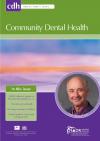Community Dental Health

- Cover Date:
- June 2016
- Print ISSN:
- 0265 539X
- Vol:
- 33
- Issue:
- 2
The mouth and dis/ability
Abstract: Our aims in this paper are threefold. First, to understand how the mouth reveals the kinds of human beings that are de/valued in speciï¬c national locations and in global discourses with special attention on disability. Second, to subject the mouth to analysis from critical disability studies, speciï¬cally, an approach we describe as dis/ability studies. Third, to ask how the mouth might work as a site of resistance for disabled people. The paper begins by providing an introduction to critical disability studies, a perspective that foregrounds disability as the primary focus for thinking through the ways in which the body and society are shaped together. We move in this literature
review towards a dis/ability studies approach that recognises the simultaneous processes of disablism (the exclusion of people with impairments) and ableism (the system by which standards of human autonomy and capability are made as key indicators of human worth). We then analyse the mouth in relation to pathologisation, human enhancement and resistance. We conclude with some ï¬nal thoughts on the offerings of a dis/ability studies approach to those of interested with the intersections of the mouth and society.
Key words: disability; mouth; neoliberal; ableism; disablism
doi:10.1922/CDH_3715Liddiard04
- Article Price
- £15.00
- Institution Article Price
- £
- Page Start
- 152
- Page End
- 155
- Authors
- K. Liddiard, D. Goodley
Articles from this issue
- Title
- Pg. Start
- Pg. End
- Child oral health in migrant families: A cross-sectional study of caries in 1-4 year old children from migrant backgrounds residing in Melbourne, Australia
- 100
- 106
- Feasibility, utility and impact of a national dental epidemiological survey of three-year-old children in England 2013
- 116
- 120
- A bi-level intervention to improve oral hygiene of older and disabled adults in low-income housing: results of a pilot study
- 127
- 132
- Caries and costs: an evaluation of a school-based fluoride varnish programme for adolescents in a Swedish region
- 138
- 144
- Examiner reliability in fluorosis scoring: a comparison of photographic and clinical methods
- 145
- 150
- Do ‘poor areas’ get the services they deserve? The role of dental services in structural inequalities in oral health
- 164
- 167
